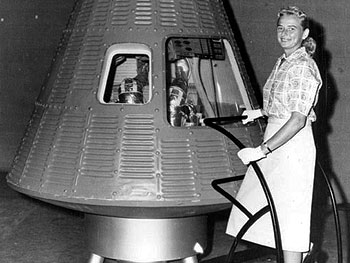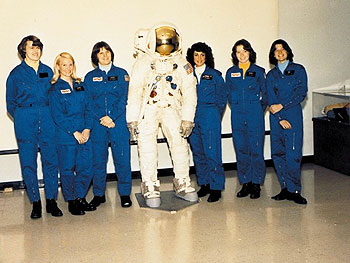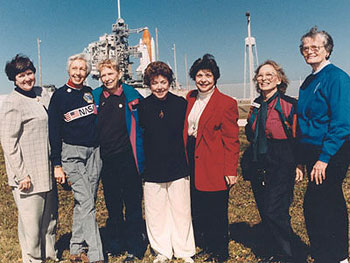We Can Do It (Better): The Women Of The Mercury Program, The “Mercury 13”
Published on March 30th, 2011 in: Back Off Man I'm A Feminist, Feminism, Issues, Science and Technology |By Emily Carney

Jerrie Cobb, test pilot, stands next to a Mercury capsule.
I was born in 1978, and it is difficult for me to believe that in the late 1950s and early 1960s, the world was still rife with prejudices based on race, ethnicity, and gender. I joined the US Navy in 1997, and was sometimes exposed to painful instances of discrimination based upon my gender and general appearance. It is very upsetting to come to the realization that people may dislike you and prevent you from doing your job based on something you can’t change.
By 1960, the US military had already proven that women could serve as honorably as men (via programs like WACS and WAVES). However, women served in the military in an exceptionally limited capacity. For example, in the US Navy, women would not be allowed on combatant ships for several more decades. Most military women served in fields such as nursing, or did secretarial work; women in engineering or aeronautics were generally unheard of. There were—and had been—many successful female pilots and engineers who were civilians.
In 1959, the newly-formed National Aeronautics and Space Administration (NASA) was just beginning to experiment with rocketry in order to eventually launch humans into orbit (the end goal being a manned lunar landing, which was achieved in 1969). The organization recruited many male military test pilots to undergo physiological and psychological testing.

First women astronauts, 1979
From left: Shannon Lucid, Rhea Seddon, Kathryn Sullivan, Judith Resnik, Anna Fisher, and Sally Ride.
A few men, such as future astronauts Jim Lovell, Jack Swigert Jr., and Charles “Pete” Conrad would be disqualified due to medical concerns (all three men would ultimately be accepted into the astronaut program during the 1960s, and ended up flying historical lunar missions). NASA did accept seven men into the fold to fly on the seminal Mercury missions. Virtually all of the early NASA astronauts were military test pilots (save for perhaps Neil Armstrong, who was a civilian test pilot).
Notably, women were not spoken of as being “appropriate” for acceptance into the new astronaut class. In 1960, pilot Jerrie Cobb—a woman who was a test pilot herself for North American Aviation and held four altitude records—was asked to undergo the same rigorous testing given to the men accepted as NASA astronauts. As she finished the first phase of testing, she achieved something no one expected.
She ended up performing well on all of the tests, despite all predictions. She passed the exact same tests that the men of Mercury 7 had passed.
Jerrie was then asked about any other women who may have been able to do well in the initial testing phases; she handpicked 25 other women. Thirteen of the women, including Jerrie, made it through the extensive battery of tests. Keep in mind that these 13 women were subjected to the exact same rigorous tests that the Mercury 7 were. These women were also among the best test pilots—male or female—of the period. So, why have we not heard about them in worshipful detail, like we have about the men of NASA in the 1960s? Why were they ultimately not allowed to participate in any manned space flight programs?
In the early 1960s, the United States was very much a different place than it is now. The Civil Rights Act—which made it illegal to discriminate against anyone based on gender or ethnic background—was not passed until 1964. Many African-Americans were still forced to pay poll taxes, and were threatened if they even attempted to vote. Many of the women tested at that time had flown more hours than some of the male Mercury 7 astronauts. The women of the Mercury 13 would eventually bring their case to Congress.

FLATS: “First Lady Astronaut Trainees,” 1995
From left: Gene Nora Jessen, Wally Funk, Jerrie Cobb, Jerri Truhill, Sarah Rutley, Myrtle Cagle and Bernice Steadman.
These women were among the Mercury 13.
Despite their arguments—that some of the men of the Mercury 7 lacked engineering degrees and, had even less flight time than the women who were tested— the Mercury 13 were shot down in their quest to bring women to a wholly integrated space program. A frustrated, disappointed Jerrie Cobb would return to her work as a pilot, eventually becoming a missionary pilot in the Amazon.
Only in 1978 would women be accepted into NASA as legitimate astronauts. One of these women, Sally K. Ride, was the first American woman in space in 1983. Tragically, another member of the class of 1978, Judith Resnik, would lose her life in the 1986 Challenger explosion.
In an interesting twist, in 1963 the Soviet Union beat the US to the punch and sent their own woman, 26-year-old textile worker Valentina Tereshkova, into space on a Vostok capsule. She spent three days in space—more than any male American astronaut had at that time—and made 48 orbits around Earth. This fact should have proven that women could more than hold their own in spaceflight. Apparently, it didn’t.
Only in the 1990s would women assume pilot and commander status on US manned space missions. It was a long time coming, but the thirteen women of the Mercury program, in their own way, had already assumed their own place in the manned spaceflight canon, whether anyone liked it—or not. Now let’s get these badass women into space already!
For more information about the Mercury 13, visit this site.
She Should Have Gone To The Moon, a film about one of the members of the Mercury 13, Jerri Truhill, is available on DVD. It can be ordered via this website.
Time limit is exhausted. Please reload the CAPTCHA.